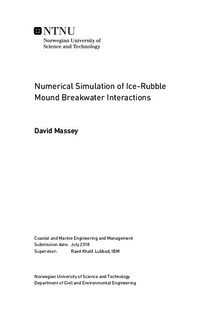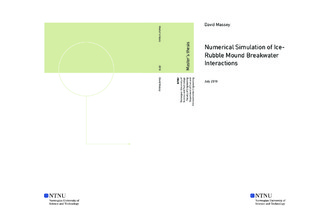| dc.description.abstract | Offshore activity in energy production, fishing, shipping, and tourism is projected to increase in the Arctic and Sub- Arctic. This projected increase in offshore activity means the supporting coastal infrastructure needs to be expanded. All human activity in ice-prone regions requires a specialized knowledge and understanding of ice mechanics and how to properly design against ice forces and ice-structure interactions. Analyzing ice-structure interactions is a prerequisite for any successful venture into areas where sea ice can occur. This thesis studied numerically modeling the interaction between pre-broken, rigid ice sheets and wide, sloping structures. The thesis focused on adapting a numerical model and validating the base phenomena of the simulated ride-up and pile-up.
The numerical model used in this study is the Simulator for Arctic Marine Structures (SAMS). SAMS has previously been validated for ship-shape structures, and individual modules within SAMS has been validated for a wider range of applications. However, coastal structures with wide, upward slopes were previously unanalyzed, and SAMS required a few modifications before simulations could proceed. Due to limitations in the version of SAMS used for this study, level sheet ice was approximated with a section of pre-broken, rigid bodies being driven by a significantly larger, unbroken sheet. Ice was driven by simulated current and wind, thus a limit-force scenario could theoretically be reached. Side confinement was used to reduce the three dimensional (3D) effects introduced in the rigid-body approximation.
For ride-up, 36 test conditions were used with ice thicknesses between 0.5 and 1 m, velocities between 1.0 and 2.0 m/s, and the slopes of 1:4 to 1:6. Each test combination was repeated 40 times for a total 1440 simulations. Results from the tests show ride-up is both qualitatively and quantitatively well represented with an 18.9% difference between the simulations and Christensen's analytical model for ride-up.
For pile-up, 22 tests conditions were used with values similar to those found in the North Caspian Sea. The ice thickness was 0.15 m, the velocity was 0.5 m/s, and the slope was 1:3. Simulations were designed to test the effects of ice-ice friction, ice-structure friction, and rubble geometry on the pile-up behavior of SAMS. Qualitatively, pile- up simulations showed 5 distinct stages of simulation: 1) initial ride-up, 2) initial pile-up, 3) rubble-pile development, 4) ice-sheet failure away from the pile, and 5) the unbroken ice sheet directly influencing the pile. Stages 1-3 correspond with the expected behavior of pile-up, but stages 4 and 5 represent unrealistic behavior caused by the rigid-body approximation. Quantitatively, ice loads ranged between 3 and 9 kN/m, porosity between 0.35 and 0.65, the pile sail from 1-3 m, and the pile keel was not consistently grounded. Sensitivity tests have shown pile-up in SAMS is: 1) sensitive to changes in ice-ice friction for lower friction coefficients and relatively insensitive for higher friction coefficients, 2) small increases in ice-structure friction can exaggerate the aberrant stages, and 3) triangular rubble geometry can exaggerate the aberrant stages. | |

